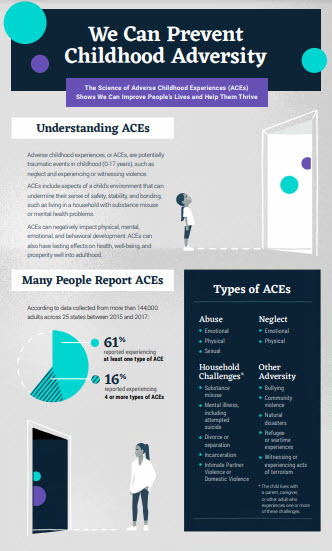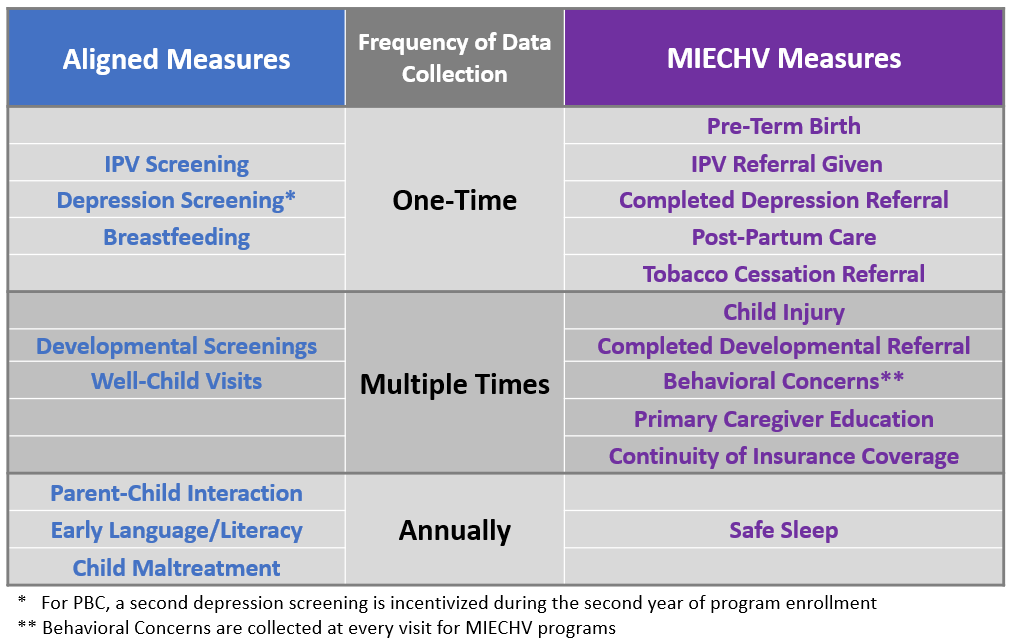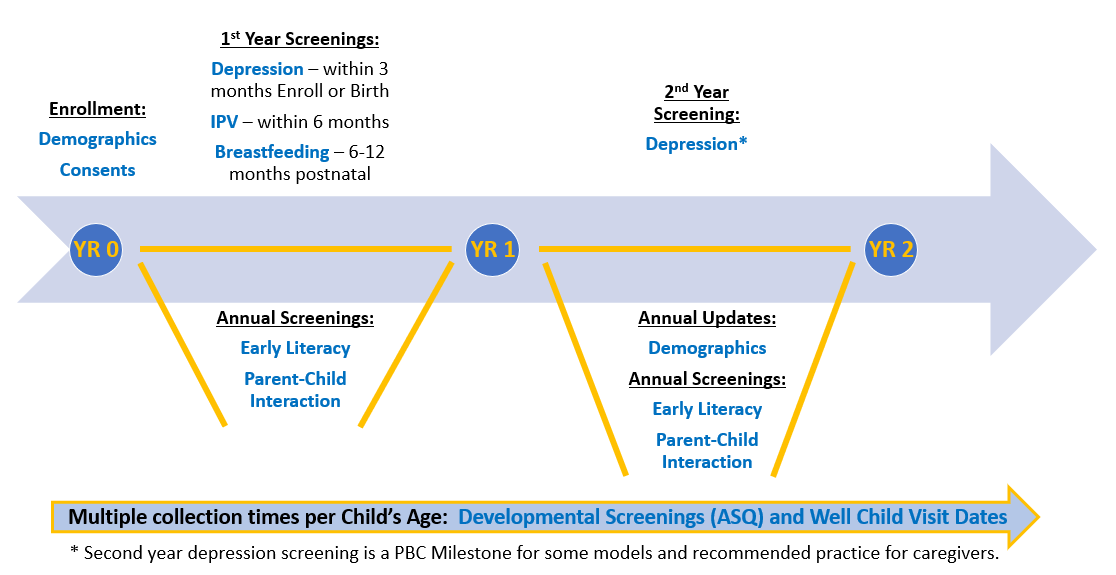
A new CDC infographic shows the impact of Adverse Childhood Experiences (ACEs) and how preventing ACEs can help create neighborhoods and communities where every child thrives. This infographic showcases data from the CDC-Kaiser Permanente ACE Study and recent findings to address the following questions:
- What are ACEs?
- How common are ACEs?
- How do ACEs affect our lives?
- How do ACEs affect our society?
- What can be done about ACEs?
ACEs are potentially traumatic events in childhood (0-17 years), such as neglect and experiencing or witnessing violence. However, types of early adversity can be stopped before they start.
Safe, stable, and nurturing relationships and environments have a positive impact in creating positive childhood experiences. Their benefits can last a lifetime.
|
DCYF will release a Family Resource Center (FRC) Landscape Report in late summer. In February, DCYF contracted with a team of researchers to gather and summarize data to describe the approaches, availability, services, supports, stability, and capacity of FRCs in Washington State to better understand their potential role in efforts to prevent child maltreatment. Guided by the definition of FRCs included in HB1237 that passed in March 2021, the team conducted outreach to identify organizations in Washington meeting the criteria of that definition, invited them to complete a survey, and conducted several key informant interviews to illustrate particular issues. A total of 84 organizations responded to the survey. Preliminary results show that:
- There are likely more organizations in the state that meet or are close to meeting the definitional criteria of an FRC, but may not currently define themselves that way.
- Among survey respondents there is strong interest in connections with peer organizations and other opportunities for organizational capacity development and collective impact.
- FRC organizations stepped up respond to the COVID-19 pandemic, with about one-third of respondents indicating that during the pandemic their FRC increased the number of adults served, and nearly all FRCs reporting that they added new events, adapted their services for online delivery and increased their offerings of concrete supports.
The research team is currently compiling all of the data and is working with DCYF to plan ways to share the results with all of our statewide partners. Watch for upcoming announcements for the opportunity to see what we are learning through this study.
It is the beginning of a new state fiscal year and a good time to refocus on the cadence of data collection and reporting for your HVSA-funded families. As new families enroll and existing families continue to participate in your home visiting program, it may be helpful to think about data needs for these families across the course of their participation. This data reporting primer provides an opportunity for the HVSA to record and celebrate your successful service to families and may help identify areas for improvement. This is a brief primer on frequency of data collection. Please refer to your SFY22 DCYF Contract for more details.
The Basics
-
Service Utilization – over the past 15 months, we have asked you to record visits and encounters with families to appreciate the breadth of services and support you have provided to families during the pandemic. This information continues to resonate with funders and stakeholders and has been shown to be a key data point in advocacy work for the HVSA. Please remember to report all:
- Enrollment and exit dates.
- Funding codes.
- Visits – all visits meeting model criteria that occur in person, video, or via phone.
- Encounters – bi-directional engagements with families via in-person, email, text, phone, or other interaction with families that don’t constitute a home visit due to minimal time and/or minimal model content shared.
-
Demographics – information on whom you are serving including children, caregivers, and families. Demographic data should be collected upon enrollment and updated annually thereafter and must be collected for all caregivers entered in your data system if your program serves multiple caregivers in a family.
-
Consent – consent from the guardian to participate in your home visiting program is collected at enrollment. Additional consent to share confidential data (e.g., names, address) should be requested within three home visits and updated after birth of infants.
-
Performance Measures – these measures included HVSA Aligned Measures and MIECHV-specific measures (see HVSA Measures Requirements Matrix for measure definitions).
Frequency of Collection and Reporting
The timing of data collection has a direct impact on measuring performance for routine indicators reported on for the HVSA. Remembering the cadence of data reporting will help ensure that data collection is complete and timely. There are three basic reporting types and measures:
-
One-time collection/reporting – these are measures that require collection once during service, typically with strict parameters around the timing of the data collection. For example, Breastfeeding at 6 months of age is a question that must be asked when an infant is older than 6 months of age and younger than one year; IPV screening must be completed within six months of enrollment in home visiting. Although models may recommend collection more frequently or it may be in the best interest of the family to collect more frequently, these measures are minimally required one-time.
-
Multiple data collection/reporting– the frequency of data collection for these measures varies with the age of the child (e.g., Developmental Screenings and Well Child Visits) and/or with potential events or changes within the family (e.g., Child Injury, Caregiver Education, and Insurance Coverage). For child developmental screenings, it is important to have a reminder system in place to prompt routine age-appropriate screenings throughout the period of enrollment. For well child visits and child injuries, collecting this information at every visit is recommended although some models may recommend data collection less frequently.
-
Annual data collection/reporting – these measures require repeat data collection at minimum one time per every state fiscal year. Parent-Child Interaction (PCI) is a required observation and assessment of the primary caregiver’s interaction with their child. Some models recommend completing the PCI early on in enrollment then annually thereafter, while other LIAs may designate a certain month for all PCI assessments. Early Literacy and Safe Sleep questions may be completed as often as is helpful with a minimum of once per year. Child Maltreatment is produced annually in September using administrative data from CPS.
Reporting Frequency
 Click on the image above to view a larger version
Routine Reporting Following Time Period of Services
To put this data collection in perspective, it may help to think about the series of services, screenings, and data collection needs over the entire course of services for an enrolled family. Below is a timeline covering two years, noting data required at Enrollment (demographics, consents); one-time first year screenings and annual screenings in Year 1; and updates and repeat screenings in Year 2. For families enrolled past the second year, the Annual Updates and Annual Screenings will be repeated for every additional year enrolled. Note, MIECHV-only data elements not included in this timeline.
Reporting Over Course of Services
 Click on the image above to view a larger version
Questions?
Please do not hesitate to reach out with any questions regarding data requirement, collection and reporting, or data training needs you have. You may contact your DCYF Program Specialist or one of the DOH data team members who are happy to help.
The Washington State Department of Health (DOH) is developing a statewide Universal Developmental Screening (UDS) data system that will track developmental screenings birth through age 55. The project was approved by the state legislature and is on track to go live this fall. Once the system is launched, health care providers and parents/legal guardians will be able to look up a children’s screening record as well as enter new information into the system. Future versions will expand the user base to authorized early childhood partners – including home visitors.
Even before the user base is expanded, home visitors can engage with the new system by encouraging and assisting parents to register as users and enter the results of a home-visiting screening. The child’s health care provider will then have access to the information and can follow up with the family as appropriate. Over time, the child will have a lifetime record of when and where screenings were conducted, what the results were, and whether there was follow up evaluation and/or connection to services – information that will be useful in the home visiting setting!
It is the hope of DOH and our collaborative partners that this system will help increase screening rates, connection to services, and health equity in the early years of a child’s life – when supportive interventions can have the greatest impact.
Questions about the UDS project? Feel free to contact Marilyn Dold at marilyn.dold@doh.wa.gov.
June Webinar Identifying and Strengthening Relationships with Referral Partners
Small group discussions focused on using an affinity diagram to brainstorm and then organize ideas and notes into themes related to managing, strengthening and creating referral relationships with community partners. Groups had the opportunity to create their own affinity diagrams to map out strengths, challenges and strategies used to foster relationships between different types of community providers. Some trends and categorizing included types of communication, supporting existing or new connections, and activities between programs and providers.
CQI PDSA Log Change Ideas:
 Breakout Group Discussion
- Who do you have referral partnerships with?
- Who do you wish you had partnerships with?
- What’s the nature of your connections with referral partners?
- What strategies do your team use to support connections with referral partners?
June Identifying and Strengthening Relationships with Referral Partners Breakout Notes
Affinity Diagram Exercise
Resources
Upcoming Dates CQI webinars are held every fourth Wednesday from 1:30–2:30 p.m.
July 28 (1:30–2:30 p.m.)
Topic: CQI Refresher and FY22 Updates
Reminders
New Supervisors: To receive the monthly calendar invite, updates and access to Basecamp, reach out to rcontreras@startearly.org.
For questions or support with any of these tools or CQI please reach out to Camille Carlson – Manager of Quality Improvement and Innovation, ccarlson@startearly.org.
Training Opportunity
Mahogony Moms Community Coalition & Breastfeeding Friendly Washington Presents:
Shifting the Conversation: Black Voices Matter Honoring the Stories and Lived Experiences of
Black Birth Workers & Community. This training is tailored for maternity care nurses, doctors, midwives, obstetricians, lactation consultants, doulas, birth workers, and community members who want to:
- Provide respectful, kind, culturally appropriate care to Black people who are pregnant or lactating.
- Access intentional resources for families.
- Gain a stronger understanding of how implicit biases and racism can impact individualized prenatal/postpartum care.
Cost: $50 (CEUs offered)
Register Here: https://MMCC2021.bpt.me
Join virtually August 26, 8 a.m. – 4:30 p.m. for an unforgettable maternity care practice training event during Black Breastfeeding Week and World Breastfeeding Month!
Tribal Term of the Month
Each month, DCYF ESIT Tribal Program Consultant Brian Frisina will provide a key topic to help support us all in getting to know our Tribal Nations partners better.
The Canoe Way: A Sacred Journey
Watch the incredible journey documented in Canoe Way. The Sacred Journey documents the annual Tribal Journeys of Pacific Northwest Coast Salish people. Indigenous tribes and First Nations from Oregon, Washington, Canada, and Alaska follow their ancestral pathways through the waters of Puget Sound, Inside Passage, and the Northwest Coast. Families and youth reconnect with the past and each other. Ancient songs, dances, regalia, ceremonies, and language that were almost lost are now coming back. Witness firsthand, through the words and images of proud people, as they share the story of the resurgence of the cedar canoe societies, and how it has opened a spiritual path of healing through tradition.
Learn More: The Kwamut Le Lum and Quwutsun Canoe Family stand together to sing The Coast Salish Anthem at the Paddle to Swinomish Main Protocol: Coast Salish Anthem ( Chief Dan George Prayer) - Quw'utsun Canoe Family / Kwamut Lelum
Community/Stakeholder - Office of Equity Strategic Planning Listening Survey
Survey Purpose: To gather the collective wisdom for co-creating a five-year equity strategic plan that helps Washington to bridge opportunity gaps and reduce disparities so everyone in Washington flourishes and achieves their full potential for the next seven generations and beyond.
Promoting access to equitable opportunities and resources that reduce disparities and improves outcomes for everyone statewide across state government, for the next seven generations and beyond, is all of our work. We need you. Please take a moment to answer these survey questions by Friday, July 30, 2021. Take the Survey.
For more information on DCYF's Equity work, you can read the Strategic and Racial Equity Plan.
Equity Resources
Watch "A Living History of the LGBT Movement" on YouTube powered by AARP: a storytelling series honoring past, present, and future heroes of the LGBT movement. By understanding our history, we can create a better future for everyone.
Help Me Grow
A new Help Me Grow Washington 101 video is an introduction into who they are and how they organize their work. This is a great resource for those looking to learn more about and get involved with Help Me Grow Washington and we encourage you share it with the families and communities you serve. To watch the video, please visit the Help Me Grow WA website.
Fair Start for Kids Act Webpage
DCYF recently launched a webpage dedicated to the Fair Start for Kids Act. High-quality child care and early learning are critical to a child’s success in school and life. With the passage of the Fair Start for Kids Act (SB 5237) on May 7, 2021, lawmakers provided an opportunity to make child care more accessible and affordable for all families in Washington State. The page will contain all information about Act implementation, including:
- Working Connections Child Care and Early Childhood Education and Assistance Program (ECEAP) changes for families
- How the Act is supporting child care and early learning providers
- Expanded resources and innovations for child care licensing
- Prenatal to age three supports for families and providers
- Data and accountability measures that DCYF reports on over the years
This webpage will be updated frequently as the agency moves through implementation. Questions can be sent to dcyf.fairstart@dcyf.wa.gov.
|